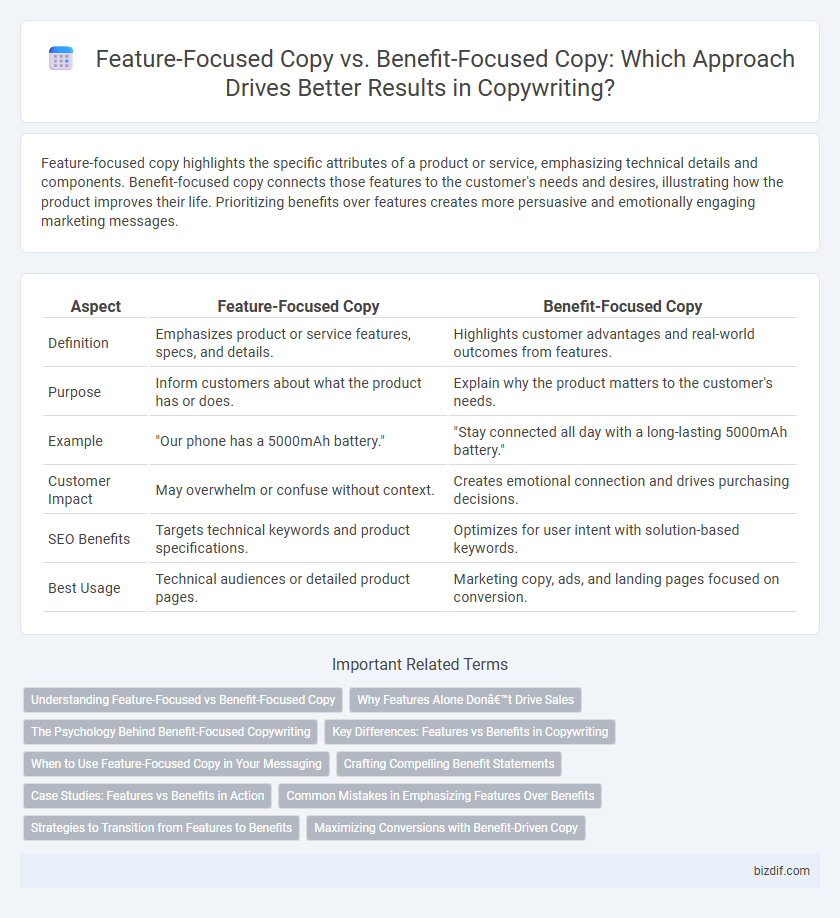Feature-focused copy highlights the specific attributes of a product or service, emphasizing technical details and components. Benefit-focused copy connects those features to the customer's needs and desires, illustrating how the product improves their life. Prioritizing benefits over features creates more persuasive and emotionally engaging marketing messages.
Table of Comparison
| Aspect | Feature-Focused Copy | Benefit-Focused Copy |
|---|---|---|
| Definition | Emphasizes product or service features, specs, and details. | Highlights customer advantages and real-world outcomes from features. |
| Purpose | Inform customers about what the product has or does. | Explain why the product matters to the customer's needs. |
| Example | "Our phone has a 5000mAh battery." | "Stay connected all day with a long-lasting 5000mAh battery." |
| Customer Impact | May overwhelm or confuse without context. | Creates emotional connection and drives purchasing decisions. |
| SEO Benefits | Targets technical keywords and product specifications. | Optimizes for user intent with solution-based keywords. |
| Best Usage | Technical audiences or detailed product pages. | Marketing copy, ads, and landing pages focused on conversion. |
Understanding Feature-Focused vs Benefit-Focused Copy
Feature-focused copy highlights the specific attributes and technical details of a product, providing clarity about what it is and how it functions. Benefit-focused copy emphasizes the value and positive outcomes the customer gains, addressing emotional needs and solving problems. Understanding the distinction helps marketers craft compelling messages that either inform or persuade, depending on the audience's stage in the buying process.
Why Features Alone Don’t Drive Sales
Feature-focused copy highlights product specifications and technical details but often fails to connect emotionally with customers, limiting its impact on purchasing decisions. Benefit-focused copy translates these features into meaningful outcomes, demonstrating how the product solves problems or improves the user's life. Understanding that consumers prioritize value and personal relevance explains why features alone don't drive sales effectively.
The Psychology Behind Benefit-Focused Copywriting
Benefit-focused copywriting taps into the customer's intrinsic motivations by highlighting how a product or service improves their life, creating an emotional connection that drives decision-making. This approach aligns with psychological principles such as Maslow's hierarchy of needs, appealing directly to desires like security, esteem, and self-actualization. By emphasizing tangible benefits rather than just features, marketers can increase engagement, foster trust, and boost conversion rates through persuasive storytelling that resonates with consumer values.
Key Differences: Features vs Benefits in Copywriting
Feature-focused copy highlights the specific attributes, specifications, or functionalities of a product, providing detailed information that appeals to a customer's logical decision-making. Benefit-focused copy emphasizes the positive outcomes, emotions, or improvements the customer will experience, making the message more relatable and persuasive by addressing their needs and desires. Understanding the key differences between features and benefits enables copywriters to craft messages that resonate more effectively, driving engagement and conversions.
When to Use Feature-Focused Copy in Your Messaging
Feature-focused copy is most effective when targeting a technical audience that values detailed product specifications and functionality. Use feature-centric messaging to highlight unique attributes, such as cutting-edge technology or proprietary materials, that differentiate your offering from competitors. This approach suits early-stage product launches or B2B marketing where informed decision-making relies heavily on concrete product details.
Crafting Compelling Benefit Statements
Benefit-focused copy highlights how a product or service improves the user's life, making the message more relatable and persuasive than feature-focused descriptions alone. Crafting compelling benefit statements requires understanding the customer's pain points and aspirations to clearly communicate value and drive engagement. Emphasizing emotional and practical outcomes helps convert interest into action by showing real-world advantages.
Case Studies: Features vs Benefits in Action
Case studies highlight the impact of feature-focused copy by detailing product specifications, such as battery life or material durability, which appeal to technical buyers seeking concrete information. Benefit-focused copy emphasizes the emotional or practical outcomes, like increased productivity or enhanced comfort, resonating with consumers driven by personal needs and desires. Analysis of real-world campaigns demonstrates that combining both approaches, while prioritizing benefits, often leads to higher engagement and conversion rates.
Common Mistakes in Emphasizing Features Over Benefits
Emphasizing features over benefits often leads to copy that fails to connect with the audience's needs and desires, resulting in reduced engagement and conversion rates. Marketers frequently mistake detailed feature lists for persuasive content, overlooking the importance of translating these attributes into tangible value and emotional appeal. This common error undermines the effectiveness of copywriting, as consumers prioritize how products or services improve their lives over technical specifications.
Strategies to Transition from Features to Benefits
Effective copywriting requires shifting from listing product features to highlighting customer benefits, emphasizing how features fulfill specific needs or solve problems. Strategies include using clear, relatable language to translate technical details into real-world advantages and crafting narratives that connect with the target audience's desires and pain points. Employing customer testimonials and storytelling techniques further bridges features with tangible emotional or practical outcomes, enhancing engagement and conversion rates.
Maximizing Conversions with Benefit-Driven Copy
Benefit-focused copy drives higher conversions by clearly communicating how a product or service improves the user's life, addressing specific pain points and desires. Emphasizing outcomes such as increased efficiency, cost savings, or enhanced satisfaction creates emotional connections that motivate purchases. While feature-focused copy highlights product attributes, integrating benefits translates those features into tangible advantages, maximizing persuasive impact.
Feature-Focused Copy vs Benefit-Focused Copy Infographic

 bizdif.com
bizdif.com